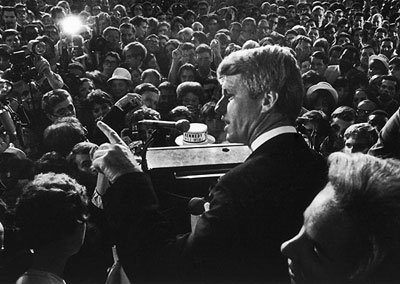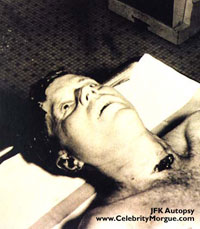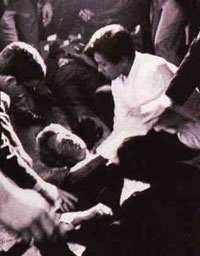Robert F. Kennedy was assassinated 42 years ago in the midst of his campaign for the U.S. presidency. Largely overshadowed by the death of his brother, President John F. Kennedy, the official account of RFK’s tragic end, allegedly shot down by a lone gunman, like his brother, has received vastly less attention. In both instances, we are looking at staged events that fit into a recurrent pattern in U.S. and world history where innocent individuals (or “patsies”) are baited and framed for cover-up purposes. Professor James H. Fetzer, an expert in the scientific study of assassinations, provides a sketch of how we know what happened to them and why, where RFK’s assassination was in part intended to prevent a reinvestigation into his brother’s death.

- Victory in California: RFK greets supporters in the Embassy Ballroom, Ambassador Hotel, in Los Angeles, on June 5, 1968.
- (Photo: Bill Eppridge)
A persistent myth of American history is that lone assassins were responsible for the deaths of Abraham Lincoln, John F. Kennedy, Martin Luther King and Robert Francis Kennedy. But four of the Lincoln conspirators were hanged from the same gallows at the same time [1]. On June 5, 1968, after RFK won the Democratic primary in California, he was shot down as he passed through the pantry of the Ambassador Hotel. The official account maintains that he was taken out by a lone, demented gunman, Sirhan Sirhan, a Palestinian who had written, “RFK must die!”, over and over in a notebook. Like the lone, demented gunman accused of assassinating his brother, John, both murders were products of conspiracies, where Sirhan Sirhan, like Lee Harvey Oswald, was designated as the patsy.
In spite of their history, most Americans continue to believe that their nation is “an exception” and that, while conspiracies occur elsewhere, including Europe and the Middle East, especially, they do not occur at home. The truth, of course, is that conspiracies are as American as apple pie. All that they require is collaboration between two or more individuals to bring about an illegal end. Most American conspiracies are economic, but many are political, too. Franklin Delano Roosevelt observed long ago that, if something important happened in politics, you could bet it was not by accident. And that is certainly the case regarding the brothers.
The assassinations of RFK and JFK were both conspiracies. Both involved the destruction of evidence. Both involved the fabrication of evidence. Both involved framing their patsies. Both involved complicity by local officials. Both involved planning by the CIA. Both were used to deny the American people of the right to be governed by leaders of their own choosing. My purpose here is to outline how these things are done, because the agencies responsible for these events continue to employ the same techniques, not only of killing their targets but of covering them up. The more we understand how these things are done, the less likely we are to be deceived again.
Some basic facts
RFK:
JFK:

- JFK at Bethesda Hospital. The throat wound had changed from Parkland Hospital, where it was a small, clean puncture wound of entry with a straight-line incision. November 22, 1963.
The assassination of RFK completed the decapitation of the left wing in the United States, which had begun with the termination of JFK’s presidency but continued with the gunning down of Malcolm X, who was the most progressive voice on the far left. With the deaths of Martin Luther King (April 4, 1968) and Robert F. Kennedy, the country shifted strongly to the right, in part from the despair induced by the loss of inspiring leaders.
The conditions required for movements capable of historic changes include intelligent, charismatic, and inspirational leaders, of whom there are very few like these. While the execution of Czar Nicholas II and his family in Russia and of Louis XVI and Marie Antoinette in France meant there was “no turning back”, removing liberal leaders cements the status quo with its distribution of wealth and power.
Read More...


Nice blog. I like your analysis of what is required for political change. However I disagree with your point about there being no intelligent, charismatic and inspirational leaders today. I personally have met dozens of them. The difference between today and the sixties is that in the sixties the popular movements they led received prominent coverage in the mainstream media. There are literally thousands of popular movements working to make change in the world today - all led by intelligent and charismatic leaders. Unfortunately they no longer make the six o'oclock news. And in this day and age it's the six o'clock news that defines reality for the majority of Americans. I have a particular interest in the JFK assassination, owing to my involvement in the early 80s with an assassination witness. I write about this, and conspiracies in general, in my recent memoir: THE MOST REVOLUTIONARY ACT: MEMOIR OF AN AMERICAN REFUGEE (I presently live in exile in New Zealand.)
ReplyDelete